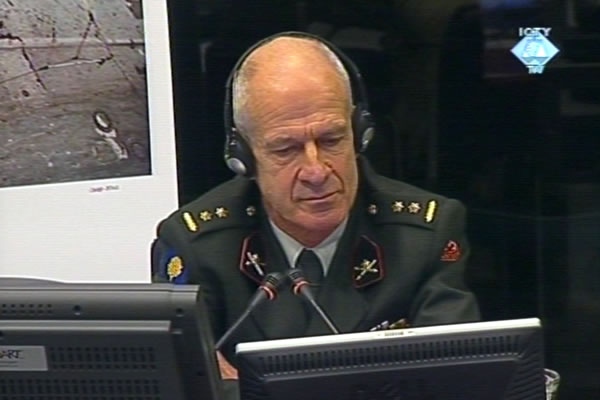Home
RANDOM SHELLING OF SARAJEVO
Former UN military observer Harry Konings confirmed at the trial of Radovan Karadzic that civilian areas in Sarajevo were targeted from April to October 1995 by ‘random’ artillery and sniper fire from the Bosnian Serb army positions
 Harry Konings, witness at the Radovan Karadzic trial
Harry Konings, witness at the Radovan Karadzic trial After a one-month break, Dutch lieutenant-colonel Harry Konings started his testimony at the trial of Radovan Karadzic. From April to October 1995, Konings was a UN military observer in Sarajevo. During that period, the witness was involved in the investigations of several sniper and artillery incidents, including the shelling of Markale town market on 28 August 1995. The incident is listed in the indictment against Karadzic. Konings has already given evidence about that at the trials of generals Dragomir Milosevic and Momcilo Perisic.
Prosecutor Carolyn Edgerton read out the summary of Konings’ written statement. The witness was the leader of a UN observers’ team at Mount Sedrenik. The position offered a good view of the city center and the lines of conflict north of the city. In about 40 out of a total of about 100 incidents the witness investigated, the victims were civilians. In most of the incidents, fire was opened from the territory controlled by the Bosnian Serb army.
As Konings explained, there was never any evidence in any of the incidents that the BH Army had planted bodies at the crime scenes and that the deadly fire had come from the positions controlled by the Bosnian army. According to the witness, as far as the Markale shelling is concerned, all the elements of the investigations conducted by the UN military observers, UNPROFOR staff and the local police pointed to the conclusion that the shall had been fired from a VRS-held position.
In the cross-examination, Karadzic put it to the witness that the investigations of sniper and artillery incidents were conducted ‘under pressure’. The investigations were ‘inadequate’ as neither the witness nor any other members of the international investigation teams examined the bodies or ‘determined whether they were fresh’, Karadzic explained. This is why their results cannot be valid in the criminal proceedings against him, Karadzic argued.
The witness explained that the pressure to complete the investigations as soon as possible was caused by the war: it was quite likely that the same site could be targeted again. His task as a UN military observer was to report to his superiors any mortar fire in his team’s area of responsibility, the witness explained, and not to establish the legitimacy of incidents. As the witness said, he was able to see for himself that civilian areas in Sarajevo were hit by random artillery and sniper fire and that most of the shells came from the Serb side.
Karadzic once again insisted that the BH Army shelled its own people, even suggesting that the BH Army also had modified air bombs in their arsenal. Karadzic maintained that three BH Army brigades with about 15,000 soldiers were deployed in civilian parts of the city within the area of responsibility covered by the witness’s observers’ team. Therefore, they were a ‘legitimate’ military target. ‘I absolutely do not believe that’, Konings replied.
The trial continues tomorrow with the evidence of a new witness.
Linked Reports
- Case : Karadzic
- 2010-11-29 EXPELLING MUSLIMS AND CROATS FROM GRBAVICA
- 2010-11-11 KARADZIC WANTS TO QUESTION FRENCH GENERAL
- 2010-11-05 ‘LET THERE BE JUSTICE, THOUGH THE WORLD PERISH’
- 2010-12-08 KARADZIC’S SUSPICIONS ABOUT MARKALE
- 2010-12-09 KARADZIC REFUSES TO BUDGE ON CLAIMS ABOUT ‘STAGED’ MASSACRES
- 2010-12-10 KARADZIC: STARI GRAD MUNICIPALITY WAS ‘TORTURE CHAMBER FOR SERBS’
